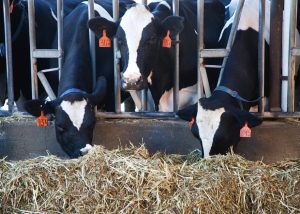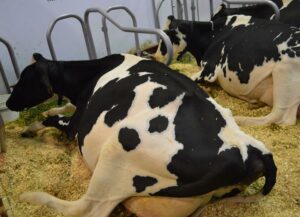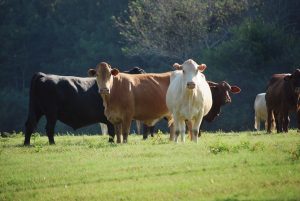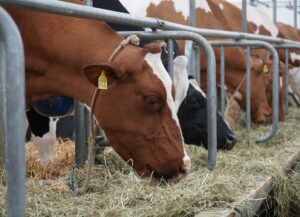Álvaro García
The phrase “milk a cow” can unintentionally frame the animal as a passive source, reducing a complex biological process to simple extraction. Though commonly used to describe the act of collecting milk, the phrase overlooks the biological and emotional complexity of the process. We often fixate on the milking machine, its parts, liner design, vacuum level, and pulsation rate, as if these alone determine success. While equipment plays a key role, we sometimes lose sight of the most critical part of the milking equation: the cow herself.
Milk is given voluntarily by the cow through a complex hormonal reflex that begins in her brain. No matter how perfect the vacuum settings or how modern the milking parlor, if the cow is stressed, startled, or poorly stimulated, she will not let her milk down properly. How often have you heard a farmer or milker refer to certain cows as “hard,” often leaving them to be milked last, so they do not slow down the entire routine?
Let-down is not a mechanical event; it is a neuroendocrine process rooted in trust, routine, and comfort. To truly optimize milking, we need to shift our mindset: from extracting milk to helping the cow release it, willingly and naturally. That shift begins by understanding how milk let-down works, what stimulates it, and what shuts it off.
From calf to parlor: understanding the natural let-down reflex
In nature, a cow gives milk to her calf when she senses it is the right moment. The sound of the calf, its smell, the gentle nudging at the udder, all serve as powerful stimuli that trigger a cascade of hormonal responses. Chief among these is oxytocin, a hormone released from the posterior pituitary gland. Oxytocin causes the muscles surrounding the alveoli in the udder to contract, pushing milk into the ducts and cisterns so it can be removed.
This let-down reflex is emotional and sensitive. Stress, unfamiliarity, or fear can block it entirely. In fact, adrenaline, the hormone released during stress and pain, directly counters the effects of oxytocin. That is why frightened or mistreated cows often fail to let down milk effectively, leading to incomplete milking and discomfort. Some cows are hard to milk not because they are uncooperative, but because something is preventing them from feeling comfortable enough to release their milk. When a cow feels calm and secure, her brain releases oxytocin, which triggers the contraction of the tiny muscles around the alveoli in the udder, pushing milk into the cisterns where it can be removed. However, if the cow is stressed, frightened, or in pain, her body releases adrenaline, which blocks the effect of oxytocin and stops milk from flowing.
Stress can come from many sources: loud noises, unfamiliar handlers, inconsistent milking routines, slippery or uncomfortable flooring, or being separated from her herd. Even subtle environmental changes or rough handling during milking can be enough to make a cow hesitant. Inadequate stimulation before milking is another common reason. If fore stripping and teat cleaning are rushed or skipped, the cow does not receive enough sensory input to trigger the full release of oxytocin. For optimal milk flow, stimulation should last at least 10 to 15 seconds, and the milking unit should be attached within a minute to take advantage of this hormone’s peak effect.
Pain or discomfort is another major barrier. A cow suffering from mastitis, teat injuries, or improperly adjusted vacuum settings may find milking physically unpleasant or even painful. Cows remember negative experiences, so if milking has been uncomfortable in the past, they may become more guarded or reactive over time. Heifers may be difficult to milk if they are not gradually and gently accustomed to the milking routine before calving. Their first impressions of the parlor shape their long-term response.
Lastly, some cows simply have more reactive or nervous temperaments. These animals are not broken; they just need more patience, gentler handling, and a stable environment to feel at ease. Occasionally, physical issues like swollen udders, tight teat canals, or anatomical challenges can also make milk flow more difficult, especially in fresh cows. Regardless of the cause, the underlying principle remains the same: cows do not give milk unless they feel safe enough to do so. Addressing their needs, physical and emotional, creates a smoother, more productive milking experience for both the cow and the handler.
Understanding physiology shifts the conversation: cows decide when to give their milk, and that decision is affected by everything from the parlor design to how they are approached before milking.
Creating the right setting
To support voluntary milk let-down, the milking environment must mimic the comfort and safety a cow feels when nursing her calf. Quiet, consistent, and predictable routines are critical. Cows prefer low, soft sounds, barking dogs, shouting, or sudden noises release adrenalin and block oxytocin release. Good ventilation, appropriate lighting (not harsh or flickering), and clean, dry footing also contribute to a cow’s sense of well-being.
Cattle rely on the presence of their herd mates for a sense of security. They feel safer and more relaxed when they are in proximity to familiar herd mates. Entering the parlor in the same order, avoiding mixing unfamiliar groups, and minimizing time spent away from the herd all help reduce stress and encourage normal behavior. Even subtle factors, like the smell of the milking area or the feel of the floor, can either promote or inhibit the let-down reflex. Slippery surfaces, abrupt transitions, or uncomfortable stalls can all become sources of anxiety.
Good handling is gentle, confident, and unrushed. Cows respond well to consistent human behavior. Nervous, impatient movements, or inconsistent treatment from one milker to another create uncertainty and block the cow’s ability to relax.
Handling: touch, timing, and trust
Fore stripping is a key part of preparing the cow, not just to remove potentially contaminated milk, but to stimulate oxytocin release. This procedure mimics the calf’s natural nudging and suckling and should be promptly followed by udder preparation, cleaning and drying the teats, and attaching the milking cluster within 60 to 90 seconds of the initial stimulation. Any delay, and the peak of oxytocin action may pass, leading to weaker milk flow and incomplete milking.
Importantly, when fore stripping is seen only to detect mastitis or discard early milk, its full role in priming the hormonal and emotional pathways of the cow is overlooked. It is not just a hygiene step; it is a critical communication step between cow and milker.
Research has shown that consistent pre-milking stimulation and proper timing of unit attachment can increase milk yield by up to 10% and reduce the incidence of incomplete milking, leading to better udder health and lower somatic cell counts (Gleeson et al. 2004).
The cow as a partner
When cows trust their handlers, when their environment feels safe, and when procedures respect their biological rhythms, they respond, not with resistance, but with cooperation.
Dairy systems are often optimized for speed and volume, but this focus can overlook the cow’s experience. She is a living being who gives milk only when she feels secure. Thinking of the cow as a partner in the process, rather than a passive object, leads to better results, not only in milk let-down but in long-term health, production, and farm harmony.
Changing the language around milking, moving from “extraction” to “letting down”, invites a deeper shift in how we design our facilities, train our workers, and evaluate our protocols. If we listen, observe, and respect her needs, the cow responds. In the end, a pleasant milking experience is not simply good for the cow. It is better for everyone involved.
© 2025 Dellait Knowledge Center. All Rights Reserved.









